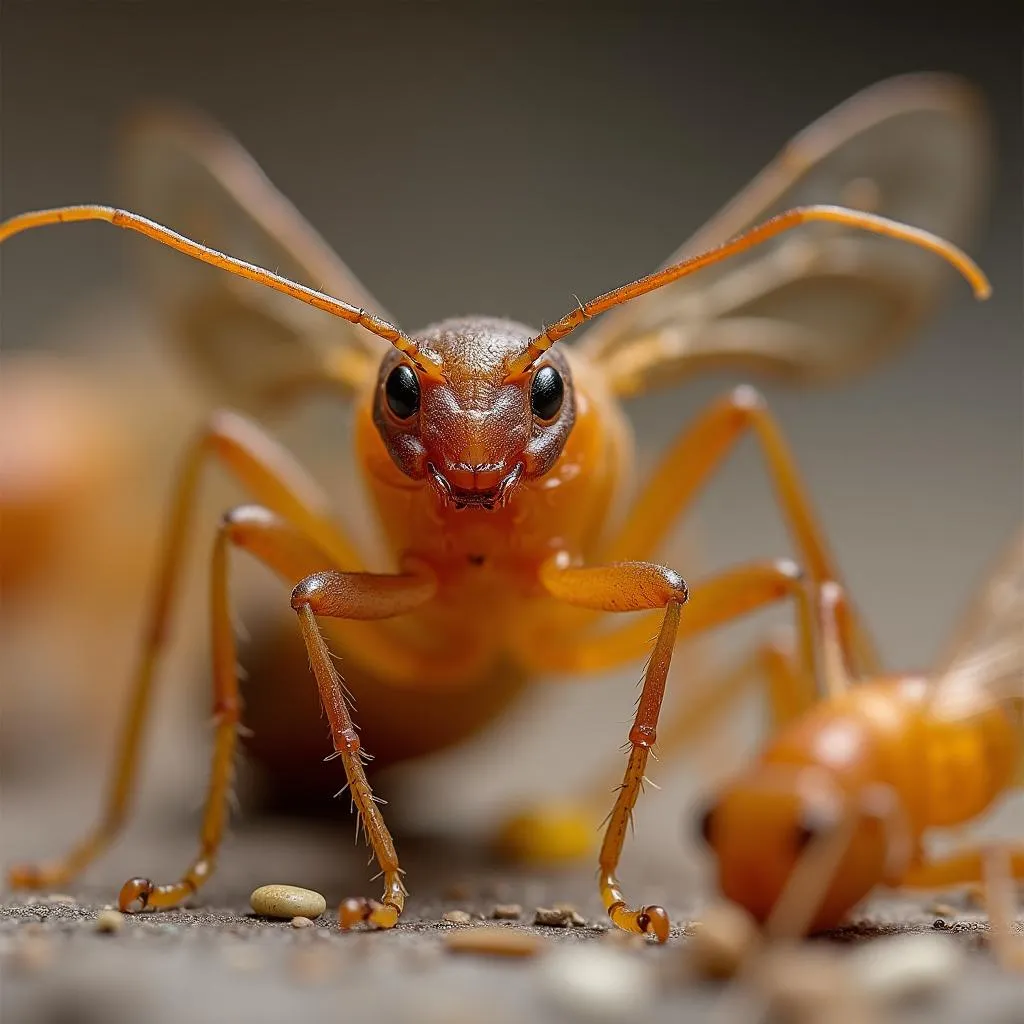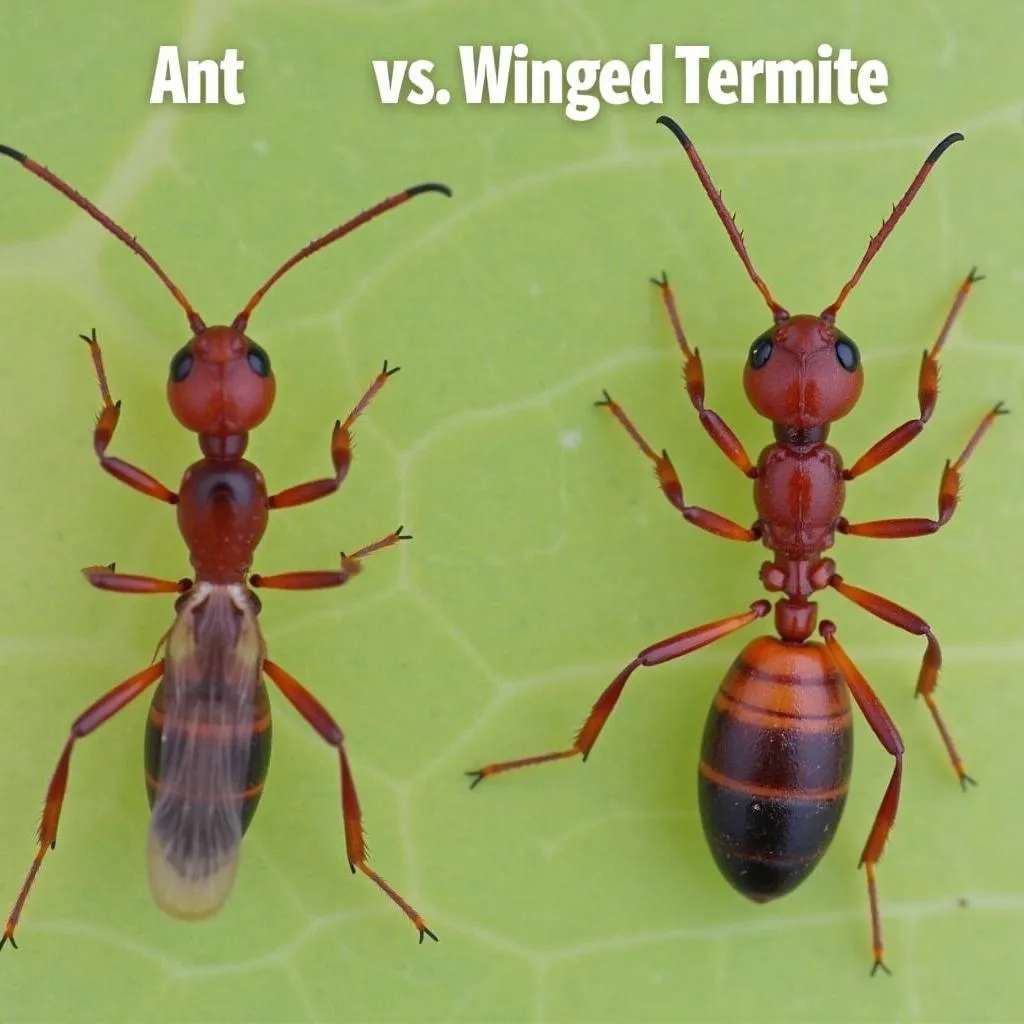You spot a swarm of insects around your home, but you’re not sure what they are. You lean in for a closer look and notice some have wings. Could these be termites? Knowing what to look for is crucial, as termites can cause significant damage to your home. One of the first questions you might have is: “What color are termites with wings?” Let’s delve into the world of these wood-destroying insects and learn how to identify them.
Termite Color: It’s Not That Simple
Unfortunately, identifying termites based on color alone isn’t easy. While the question “what color are termites with wings?” seems straightforward, the answer is a bit more nuanced. Winged termites, also known as “swarmers,” can vary in color depending on the species. Here’s what you need to know:
- Generally Dark: Most winged termites tend to have darker bodies, ranging from dark brown to black.
- Variations Exist: However, some species might have lighter shades of brown or even a reddish-brown hue.
- Focus on Other Features: Instead of solely relying on color, it’s essential to consider other identifying characteristics to determine if you’re dealing with termites.
Beyond Color: Key Identifying Features of Winged Termites
To accurately identify winged termites, pay attention to these key features:
- Straight Antennae: Unlike ants, which have elbowed antennae, termites have straight antennae.
- Broad Waist: Termites lack the distinct narrow waist found in ants. Their bodies appear more rectangular.
- Equal Wing Length: Termite swarmers have two pairs of wings that are equal in length and shape. This is a significant difference from ants, whose front wings are larger than their hind wings.
- Wings Shed: After swarming, termites shed their wings, leaving small piles of discarded wings near windowsills, doors, or other light sources.
 Winged Termite Identification
Winged Termite Identification
Mistaken Identity: Are They Ants or Termites?
Winged ants and winged termites often get mistaken for one another. Both swarm around the same time of year and share some visual similarities. However, by remembering the key differences outlined above, you can confidently distinguish between them:
| Feature | Termites | Ants |
|---|---|---|
| Antennae | Straight | Elbowed |
| Waist | Broad, no constriction | Narrow, pinched waist |
| Wings | Equal length and shape, shed after swarming | Front wings larger than hind wings |
 Ants vs. Termites
Ants vs. Termites
Why is Knowing the Color of Winged Termites Important?
While color alone might not provide a definitive answer, recognizing that winged termites generally have darker bodies is a good starting point. Combining this knowledge with other identifying features allows you to take quick action if you suspect a termite infestation. Early detection is crucial in minimizing the damage these destructive pests can inflict on your home.
What to Do if You See Winged Termites
Spotting winged termites is a strong indication of a termite colony nearby, potentially even within your home. These swarmers are responsible for establishing new colonies, and their presence warrants immediate attention. Here’s what to do:
- Don’t Disturb: Avoid disturbing the swarm or attempting to treat it yourself.
- Collect a Sample: If possible, safely collect a few termites in a jar or sealed bag for identification.
- Contact a Professional: Call a qualified pest control professional immediately. They can properly identify the species and recommend the best course of action to eliminate the infestation and protect your home.
Conclusion
So, what color are termites with wings? While their coloration can vary, understanding their other distinct features is essential for accurate identification. Remember, if you suspect a termite problem, don’t wait. Contact a pest control professional for a thorough inspection and effective treatment plan.
FAQs
1. Do all termites have wings?
No, only reproductive termites, known as “swarmers,” have wings. These termites are responsible for leaving the colony to mate and establish new colonies.
2. When do termites swarm?
Termite swarming season varies depending on the species and geographic location. However, most termites swarm in the spring or fall, often after a rainfall.
3. What attracts termites to a house?
Termites are attracted to wood, moisture, and warmth. Factors like wood-to-soil contact, leaky pipes, and poor ventilation can make a home more appealing to these pests.
4. How serious is a termite infestation?
Termite infestations can be extremely serious. These silent destroyers can cause significant structural damage to homes and other structures if left untreated.
5. How can I prevent termites?
Preventing termites involves reducing moisture, eliminating wood-to-soil contact, proper ventilation, and scheduling regular termite inspections by a qualified professional.
Need Help with Termites?
If you suspect a termite infestation or need professional pest control services, don’t hesitate to contact us.
Call us at: 0373298888
Email us at: [email protected]
Visit us at: 86 Cầu Giấy, Hà Nội
Our team of experts is available 24/7 to assist you with all your pest control needs.

